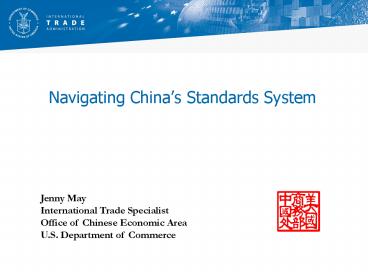Navigating Chinas Standards System - PowerPoint PPT Presentation
1 / 22
Title:
Navigating Chinas Standards System
Description:
Navigating China's Standards System. Jenny May. International Trade Specialist ... Historically, all standards development and most R&D driven by the government. ... – PowerPoint PPT presentation
Number of Views:56
Avg rating:3.0/5.0
Title: Navigating Chinas Standards System
1
Navigating Chinas Standards System
Jenny May International Trade Specialist Office
of Chinese Economic Area U.S. Department of
Commerce
2
Overview
- Landscape of Chinas Standards System.
- Common Challenges.
- Cooperative Efforts on Standards.
- Future Trend.
3
Background
- Long history of standards setting.
- Historically, all standards development and most
RD driven by the government. - Transition phase of new laws and legal system.
- Emerging economy based on manufacturing
- Growing market/middle class.
- Recognition of importance of standards in global
markets.
4
Chinese Standards System Observations
- Centralized, top- down structure.
- Regulatory reform, transitional stage.
- Pre-WTO rules and regulations.
- Focused on indigenous products.
5
Chinas Technical Standards Strategic Plan
- Improve the adaptability of technical standards
to technological, trade, industrial and market
demands. - Joint development of standards by greater
cooperation between government and enterprises. - Develop indigenous technical standards to be
competitive with international norms.
6
Strategic Goals
- By 2010, form a complete national technical
standard system on a par with international
standards. - By 2020, upgrade the overall technological level
of Chinas technical standards in key areas to
enable China to become a contributor to
international standards.
7
Centralized System
8
Major Functions of AQSIQ
9
Major Functions of SAC
- Strategize PRC standardization plan.
- Promulgate national standards (GB).
- Manage and coordinate technical committees work.
- Represent China in ISO, IEC and ITU activities.
10
Major Functions of CNCA
- Implement Chinas conformity assessment related
rules and regulations. - Oversee Chinas Compulsory Certification regime.
- Represent China in international activities,
including IAF, PAC, IPC, APLAC, ISO and IEC,
related to conformity assessment. - Oversee activities by foreign owned or joint
venture conformity assessment bodies.
11
Four Types of Standards
- National Standards (GB) by SAC.
- Industry Standards (YD) by ministries.
- Sectoral Standards by enterprises.
- Regional Standards by local authorities.
12
Examples of Involved Agencies
13
Standards Challenges
- Impartiality need independent SDOs and
conformity assessment bodies. - Openness/Transparency.
- Inter-agency coordination.
- Local protectionism.
14
Standards Cooperation with China
- Seeking a level playing field
- Objective Greater clarity and transparency in
Chinese standards and technical regulations. - Outreach Programs our interactions with Chinese
ministries to achieve common understandings on
their standards and technical regulations.
15
Multi-pronged approach for tackling standards
concerns
- Address specific issue.
- Public-Private cooperation.
- Training and capacity building.
16
Address Specific Concerns
- Sector-Specific Programs
- U.S.-China Chemicals Dialogue (2005 - present)
- U.S.-China Roundtable and DVC on Restriction of
Hazardous Substances (RoHS) (1/06) - U.S.-China Symposium on Standards and IPR (9/06).
- ANSI-NIST-SAC Technical Dialogue on Standards
(5/07). - Standards in Trade Workshop with China led by the
National Institute of Standards and Technology
(NIST) on intelligent transportation systems and
energy efficiency (05/07, 08/07).
17
Address Specific Concerns Engagement with China
on Restriction of Hazardous Substances (RoHS)
- Digital Video Conference (DVC) Oct, 06
- - Face-to-face industry to government
discussion. - Clarifications of product range.
- Potential catalog scope.
- Status upcoming standards.
- - Encourage China to notify the WTO on draft
standards. - - Involved entities MII, CNCA, CQC, CESI.
- - 90 U.S. industry reps participated in the
DVC.
18
Engagement with MII on China RoHS
- Bilateral meeting in Washington, DC Oct, 06
- Encouraged MII to continue to be transparent.
- Identify China RoHS POC to address U.S industry
questions. (chinaRoHS_at_MII.gov.cn). - Pressed the issue on RoHS effective date
manufacturing date vs. sales date. - Encouraged MII to notify related standards to the
WTO. - Pressed the importance of U.S. industrys
participation in the standards working group.
19
Next steps
- Continue to monitor the development of China
RoHS. - Need your input to help us determine open issues
and next steps. - Continue engagement with Chinese regulatory
agencies.
20
U.S. private sector China activities
- Market Development Cooperator Program (MDCP)-
supported standards activities in China - U.S. Information Technology Office (USITO).
- National Electrical Manufacturers Association
Office. - Consortia of Standards and Conformity Assessment.
- Natural Product Association office.
- ASTM International Beijing Office.
- ANSIs U.S.-China Standards Portal.
- http//www.standardsportal.org.cn/splash/default.a
spx
21
Current Perspective and Trends
- Poised to become a top ranking contributor of
international standards. - Increased Chinese involvement with international
standards. - To meet WTO/TBT demands and align with
international standards. - Western concern about PRC government intervention.
22
Thank you!
- Jenny May
- Office of Chinese Economic Area
- Jenny.may_at_mail.doc.gov
- www.export.gov/china
- Tel 202-482-5681































